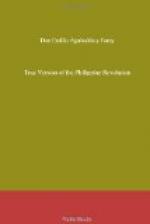In Santa Ana (the eastern section of Manila) General Ricarto successfully routed five companies of Spaniards, being aided in this by the manoeuvres of General Pio del Pilar’s brigade.
CHAPTER XIV
First Clouds
Our troops saw the American forces landing on the sea shore near the Luneta and Paseo de Santa Lucia, calling the attention of everybody to the fact that the Spanish soldiers in the city forts were not firing on them (the Americans), a mystery that was cleared up at sunset when details of the capitulation of Manila, by General Jaudenes in accordance with terms of an agreement with General Merritt, became public property—a capitulation which the American Generals reserved for their own benefit and credit in contravention of the agreement arrived at with Admiral Dewey in the arrangement of plans for the final combined assault on and capture of Manila by the allied forces, American and Filipino.
Some light was thrown upon this apparently inexplicable conduct of the American Commanders by the telegrams which I received during that day from General Anderson, who wired me from Maitubig asking me to issue orders forbidding our troops to enter Manila, a request which I did not comply with because it was not in conformity with the agreement, and it was, moreover, diametrically opposed to the high ends of the Revolutionary Government, that after going to the trouble of besieging Manila for two months and a half, sacrificing thousands of lives and millions of material interests, it should be supposed such sacrifices were made with any other object in view than the capture of Manila and the Spanish garrison which stubbornly defended the city.
But General Merritt, persistent in his designs, begged me not only through the Admiral but also through Major Bell to withdraw my troops from the suburbs to (as it was argued) prevent the danger of conflict which is always to be looked for in the event of dual military occupation; also by so doing to avoid bringing ridicule upon the American forces; offering, at the same time, in three letters, to negotiate after his wishes were complied with. To this I agreed, though neither immediately nor at one time, but making our troops retire gradually up to the blockhouses in order that the whole of the inhabitants of Manila should witness the proceedings of our troops and amicability toward our American allies.




